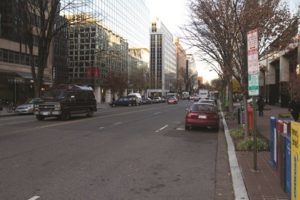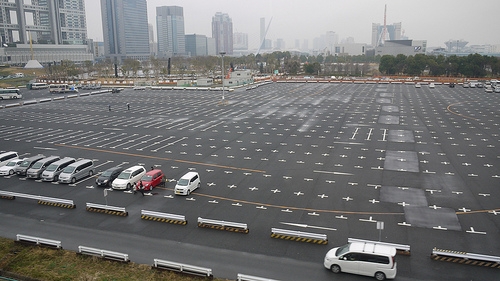
Walk around the downtown of any major U.S. city and you’ll probably see signs indicating time-of-day restrictions for on street parking. Some streets have AM peak restrictions, while many have PM peak restrictions. The rationale behind these policies is to better accommodate peak hour traffic volumes, but cities are beginning to question the wisdom of giving up valuable full time parking and the benefits that come with it.
Many peak hour restrictions are hold overs from an era when downtown areas were far more employment-centered and automobile focused. The goal of moving as much traffic through a city as quickly as possible led to the introduction of one way couples, over-sized streets and the peak hour parking restrictions which still exist today. Creating a place that people want to live, work and spend time in dramatically changes street design goals, however. As more bike lanes and complete streets projects come on line, variable automobile lane configurations based on peak traffic hours becomes incompatible with many pedestrian and cycling-focused geometric changes. Adding simple bumpouts or a traditional bike lane on a street with peak hour restrictions usually means introducing full time parking. Even without introducing cross section changes, a full time parking lane serves as traffic calming and makes life easier for nearby businesses and residents.
Peak-hour parking restrictions for general purpose travel should be limited or converted to other uses. Peak-hour lanes in urban areas, especially those that are directly next to the pedestrian’s path of travel, should be avoided. Peak-hour parking restrictions also limit the use of many other beneficial treatments, such as curb extensions, parklets, and bikeways. (NACTO, National Association of City Transportation Officials)
Opening one lane of traffic between 4pm and 6pm saves perhaps 1 or 2 minutes of travel time under perfect conditions, but this depends if the restrictions are actually obeyed. Just one person who doesn’t relocate their parked car in time can throw the entire plan out the window. It can also be said that peak hour restrictions encourage faster speeds and prioritize through traffic in areas which are becoming destinations themselves. Maximizing convenient on-street parking for local businesses can be an economic development tool, and giving nearby residents the ability to park whenever they’d like in a visible space has livability benefits. One often overlooked issue with parking restrictions involves cyclists who use the small space between the parking lane and traffic lane. Removing this space during the time when most cyclists are commuting from work requires the cyclist to take the entire lane and ride with fast peak hour traffic – something many riders are unwilling or unable to do.
Chicago eliminated a plethora of peak hour restrictions to support new bike lanes with the added benefit of improving local residential and business access, and Columbus also removed restrictions in their downtown for these very reasons. The University of Connecticut did a parking study and found full time on-street parking has substantial safety, land use and livability benefits.
We showed conclusively that drivers tended to travel at significantly slower speeds in the presence of features such as on-street parking and small building setbacks. Slower vehicle speeds provide pedestrians, cyclists and drivers more time to react, and when a crash does occur, the chance of it being life-threatening is greatly reduced. In short, on-street parking can help to create a safer environment.” (The University of Connecticut, “What Street Parking Can Do For Downtowns”)
In terms of transportation policy, it seems eliminating peak hour restrictions is a relatively low cost, high-impact thing cities can do to make their urban streets more livable. It can also create a plethora of design options, including landscaped bumpouts, bike lanes, or road diets. As cities begin to prioritize local mobility and quality of life over maximizing automobile traffic capacity, cost effective policies can go a long way in attracting new business and residents while making our streets safer.


